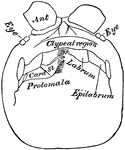Clipart tagged: ‘Cardo’

Cardo
A hinge or pivot. The first figure, in the annexed woodcut, is designed to show the general form of…

Centipede Head
"Head of Scolopendra, from below, showing the epilabrum, the protomala with its cardo (Card), and stipes…